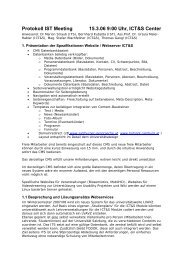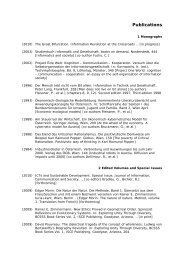ICTS AND SOCIETY: THE SALZBURG APPROACH - ICT&S
ICTS AND SOCIETY: THE SALZBURG APPROACH - ICT&S
ICTS AND SOCIETY: THE SALZBURG APPROACH - ICT&S
Create successful ePaper yourself
Turn your PDF publications into a flip-book with our unique Google optimized e-Paper software.
ICTs and Society: The Salzburg Approach<br />
Thirdly, we now can introduce the evolutionary stage model of the Net and inquire<br />
into the temporal succession of stages of, e.g., the World Wide Web. In our<br />
evolutionary model of the Web we distinguish three such stages: Web 1.0, Web 2.0,<br />
Web 3.0 (see Fig. 16 below). The stages can be seen as directly resembling the<br />
unfolding of sociality into ever higher forms of cooperation.<br />
The x-axis is the timeline and shows different phases of the evolving Web (Web 1.0,<br />
2.0, 3.0); the y-axis visualises the hierarchy of different levels, comprising the different<br />
forms of sociality (cognition, communication, cooperation). Each phase/level is<br />
the precondition for the next phase/level, but does not necessitate the next<br />
phase/level. If we shift from one phase to another, we also jump from one level to<br />
another. The new level subordinates the old level, reworks it, reontologises it, and<br />
forms together with it the system of the new phase.<br />
Figure 16: The dynamic of the techno-social self-organisation of the Web over time<br />
The stage of Web 1.0 is a web of cognition. It is mainly about the consumption of<br />
information (a cognitive process) that is presented in hypertext form. We name this<br />
state of Web evolution hypertextual.<br />
The cognitive form of sociality represents the general basic layer in our model; it<br />
builds the fundament of all three stages. But as we will see, it changes in its quality<br />
when it reappears in the subsequent stages as it is reworked by the emerging<br />
higher new levels.<br />
Since the beginning of the new millennium the character of the Web has successively<br />
been changing. With the rise of new heavily frequented platforms such as<br />
MySpace, YouTube, Facebook, Wikipedia, Friendster etc., communication and cooperation<br />
have become more important features of the Web. Our impression is that<br />
around 2005 Web 2.0 fully emerged and that the Web has entered a new phase of<br />
development. Web 3.0 is not-yet existent, but it shines forth in online cooperation<br />
systems such as Wikipedia.<br />
Hofkirchner | Fuchs | Raffl | Schafranek | Sandoval | Bichler 46









